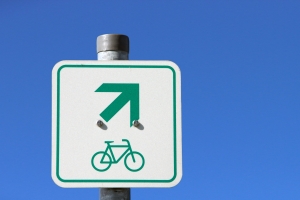- Increases in observed ridership within one year of protected bike lanes' construction ranged from +21% to +171%
- Increases appeared to be greater than overall increases in bicycle commuting in each city
- Increases were made up of 11% new riders, or riders who would not have traveled by bike without the protected lane, and 89% riders who took the route because of the new lane, but would have biked anyway
- 96% of interviewed cyclists felt that the protected lane increased the safety of bicycling on the street
- 79% of residents interviewed felt that the protected lane increased the safety of bicycling on the street
- 43% of people stated that protected bike lanes had made their neighborhoods a more desirable place to live, as opposed to 14% who believed it actually reduced desirability
- 19% of intercepted bicyclists said that they stopped at businesses along the protected bike lane more often than before its installation
- 53% of drivers in communities where protected bike lanes were installed stated that predictability of bicyclists had increased, as opposed to 12% who said it had decreased
- 14% of respondents said that they avoided roads with protected bike lanes installed
- 30-55% of residents stated that impacts to parking were negative; impact to parking was the study's most negative perception
Related Stories
| Oct 11, 2010
MBMA Releases Fire Resistance Design Guide for metal building systems
The Metal Building Manufacturers Association (MBMA) announces the release of the 2010 Fire Resistance Design Guide for Metal Building Systems. The guide provides building owners, architects, engineers, specifiers, fire marshals, building code officials, contractors, product vendors, builders and metal building manufacturers information on how to effectively meet fire resistance requirements of a project with metal building systems.
| Sep 13, 2010
Second Time Around
A Building Team preserves the historic facade of a Broadway theater en route to creating the first green playhouse on the Great White Way.
| Sep 13, 2010
World's busiest land port also to be its greenest
A larger, more efficient, and supergreen border crossing facility is planned for the San Ysidro (Calif.) Port of Entry to better handle the more than 100,000 people who cross the U.S.-Mexico border there each day.
| Sep 13, 2010
Data Centers Keeping Energy, Security in Check
Power consumption for data centers doubled from 2000 and 2006, and it is anticipated to double again by 2011, making these mission-critical facilities the nation's largest commercial user of electric power. With major technology companies investing heavily in new data centers, it's no wonder Building Teams see these mission-critical facilities as a golden opportunity, and why they are working hard to keep energy costs at data centers in check.
| Aug 11, 2010
ASHRAE publishes paper on HVAC and airborne diseases
As health and school officials deal with a second wave of the H1N1 virus, commonly referred to as swine flu, ASHRAE has published information on health consequences of exposure to such airborne infectious diseases and the implications on the design, installation, and operation of HVAC systems.
| Aug 11, 2010
Morphosis builds 'floating' house for Brad Pitt's Make It Right New Orleans foundation
Morphosis Architects, under the direction of renowned architect and UCLA professor Thom Mayne, has completed the first floating house permitted in the U.S. for Brad Pitt’s Make It Right Foundation in New Orleans.The FLOAT House is a new model for flood-safe, affordable, and sustainable housing that is designed to float securely with rising water levels.










